1
Overview
Ultrasound diagnostic systems are used in various departments because they enable noninvasive and real-time observation. Konica Minolta’s ultrasound diagnostic systems, which were developed based on the concept of “Visible,” “Easy,” and “Connected,” are highly evaluated in the POC field (bedside diagnosis and treatment) and obstetrics and gynecology in particular. Meanwhile, in recent years, hydrorelease is widely practiced to inject medical fluids using syringes and relieve pain while checking ultrasound images. However, it is essential to ensure the safety of diagnosis and treatment and strengthen training because the needle is difficult to see, and so advanced skills are required. To cope with these issues, we offer new assistant tools to improve the visibility of the needle, visualize nerves, and link with a tablet device, enabling users to provide patients with high-quality medical care easily and safely.
2
Details
■Configuration
The SONIMAGE UX1 is an ultrasound diagnostic system for the POC field, and the SONOVISTA LX is an ultrasound diagnostic system for obstetrics and gynecology. Although these products are designed for different departments, the hardware and software are mostly standardized. Multiple lineups are offered for flexible application to various layouts for use (Fig. 1).

Fig. 1 The model types of ultrasonic diagnostic system SONIMAGE UX1 and SONOVISTA LX.
■Functions / Features / Applications
1) Evolution of “Visible”: Linear Probe X20L
We improved the directional characteristics by combining materials technology with nano-fabrication technology, which are our core technologies. By changing the conventional acoustic lens, which was spherical and single-focus, to an aspherical lens, whose focus changes continuously, the ultrasound beam width has been made uniform in deeper areas. This has improved the image quality of deep areas and visibility of the needle, reducing dependence on skills (Fig. 2).

Fig. 2 The structure of linear probe X20L.
2) Evolution of “Easy”: VisNerve
The use of proprietary AI technology makes it possible to automatically detect the shape of nerve tissues and color-code and visualize detected nerves. This enables even inexperienced users to quickly identify the position of nerves, thereby improving safety of injection around nerves and reducing the time required for diagnosis and treatment (Fig. 3).

Fig. 3 Example of clinical ultrasound image with VisNerve.
3) Evolution of “Connected”: Mobile Cast
The image displayed on the ultrasound diagnostic system can be displayed on a tablet device in real time. Because the tablet can be positioned anywhere, the ultrasound image can be checked in a natural posture without strain, reducing the workload of diagnosis and treatment. This feature can also be used for training, such as allowing a skilled user to offer guidance to an inexperienced user while seeing the same ultrasound image (Fig. 4).

Fig. 4 The image diagram when using Mobile Cast.
4) Pursuit of usability
Despite the compact size for installation in a limited space, the height adjustment function is more than double that of the existing product, and the monitor and control panel can be swiveled. This has made it possible to conduct examinations in both sitting and standing postures, and to install the system in various environments (Fig. 5).

Fig. 5 The movable image of SONOVISTA LX.
■Future outlook
The SONIMAGE UX1/SONOVISTA LX ultrasound diagnostic systems have evolved “Visible,” “Easy,” and “Connected,” and feature new technologies and functions that conventional systems did not have. We will continue to evolve our products to ensure the safety of diagnosis and treatment and develop useful functions for inexperienced users.



